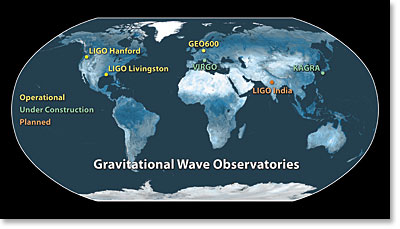LIGO gravitational wave researchers win Nobel Prize in Physics
SPIE Classics celebrates the 2017 Nobel Prize in Physics.
The 2017 Nobel Prize in Physics has been awarded to three of the key scientists involved in the first direct observation of gravitational waves.
Rainer Weiss, a professor at the Massachusetts Institute of Technology, and Kip Thorne and Barry Barish, both of the California Institute of Technology, were the architects and leaders of LIGO, the Laser Interferometer Gravitational-wave Observatory, the instrument that detected the gravitational waves, and of a sister organization, the LIGO Scientific Collaboration.
The Nobel Prize recognizes the three for their "decisive contributions to the LIGO detector and the observation of gravitational waves."

LIGO pioneers: Barish, Thorne, and Weiss.
Gravitational waves are ripples in the fabric of space time arriving at Earth from a cataclysmic event in the distant universe. LIGO made headlines when they announced the first observation of a gravitational wave in September 2015. This confirmed a major prediction of Albert Einstein's 1915 general theory of relativity and opened an unprecedented new window to the cosmos.
LIGO detected a second gravitational wave in December, 2016, and a third in January, 2017. In August, a fourth wave was detected by LIGO and Italy's Virgo interferometer.
It took four decades of persistance to finally confirm Einstein's century-old predictions, but LIGO and Virgo are now providing a completely new astronomical toolkit with which to observe the Universe.

Gravitational-wave observatories across the globe. (Caltech/MIT/LIGO Lab)
The Royal Swedish Academy of Sciences, which awards the Nobel prizes, described the observation of gravitational waves as a "truly remarkable achievement," adding:
"Einstein was convinced it would never be possible to measure them. The LIGO project's achievement was using a pair of gigantic laser interferometers to measure a change thousands of times smaller than an atomic nucleus, as the gravitational wave passed the Earth."
Related SPIE content:
Gravitational waves
Birth of a new astronomy
The Optics of LIGO
How high-precision optics enabled detection of gravitational waves and a new view of the universe
LIGO optics: initial and advanced
The LIGO project has completed the installation of large fused silica optical components in the vacuum systems of its observatories.
Third gravitational wave detected
SPIE Classics offers a look at the timeline of LIGO's historic discoveries of gravitational waves.
Photonics is a Nobel cause
SPIE celebrates 2014 Nobel Prize winners



